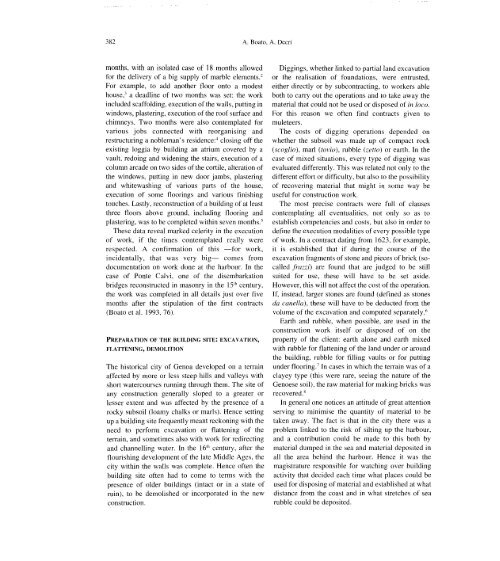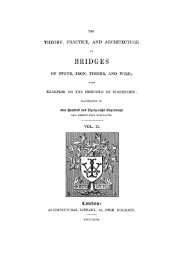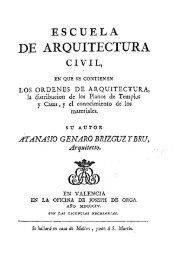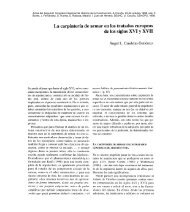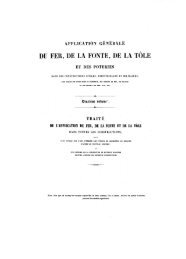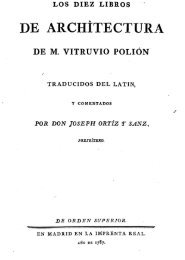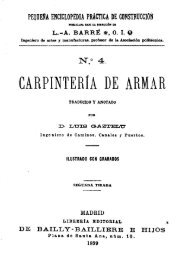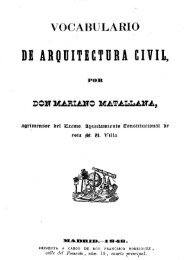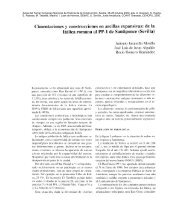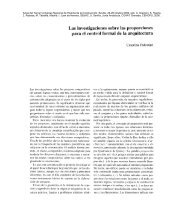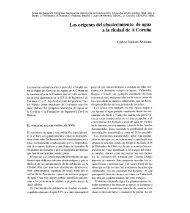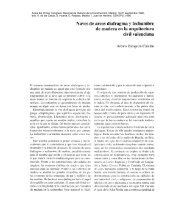Archive documents and building organisation. An example from the ...
Archive documents and building organisation. An example from the ...
Archive documents and building organisation. An example from the ...
You also want an ePaper? Increase the reach of your titles
YUMPU automatically turns print PDFs into web optimized ePapers that Google loves.
382 A. Boato, A. Decri<br />
months, with an isolated case of 18 months allowed<br />
for <strong>the</strong> de]ivery of a big supp]y of marb]e e]ements.2<br />
For examp]e, to add ano<strong>the</strong>r t100r onto a modest<br />
house,3 a dead]ine of two months was set: <strong>the</strong> work<br />
included scaffo]ding, execution of <strong>the</strong> walls, putting in<br />
windows, p]astering, execution of <strong>the</strong> roof surface <strong>and</strong><br />
chimneys. Two months were a]so contemp]ated for<br />
various jobs connected with reorganising <strong>and</strong><br />
restructuring a nob]eman' s residence:4 closing off <strong>the</strong><br />
existing ]oggia by <strong>building</strong> an atrium covered by a<br />
vault, redoing <strong>and</strong> widening <strong>the</strong> stairs, execution of a<br />
co]umn arcade on two sides of <strong>the</strong> corti]e, a]teration of<br />
<strong>the</strong> windows, putting in new door jambs, p]astering<br />
<strong>and</strong> whitewashing of various parts of <strong>the</strong> house,<br />
execution of some floorings <strong>and</strong> various finishing<br />
touches. Last]y, reconstruction of a <strong>building</strong> of at ]east<br />
three floors above ground, including flooring <strong>and</strong><br />
p]astering, was to be comp]eted within seven months.5<br />
These data reveal marked celerity in <strong>the</strong> execution<br />
of work, if <strong>the</strong> times contemp]ated really were<br />
respected. A confirmation of this -for work,<br />
incidentally, that was very big- comes <strong>from</strong><br />
documentation on work done at <strong>the</strong> harbour. In <strong>the</strong><br />
case of Ponte Cal vi, one of <strong>the</strong> disembarkation<br />
bridges reconstructed in masonry in <strong>the</strong> ]5'h century,<br />
<strong>the</strong> work was comp]eted in aJl details just over five<br />
months after <strong>the</strong> stipu]ation of <strong>the</strong> first contracts<br />
(Boato et al. ]993, 76).<br />
PREPARATION OF THE BUILDING SITE: EXCAVATION,<br />
FLATTENING, DEMOLITION<br />
The historical city of Genoa deve]oped on a terrain<br />
affected by more or les s steep hiJls <strong>and</strong> valleys with<br />
short watercourses running through <strong>the</strong>m. The site of<br />
any construction generaJly sloped to a greater or<br />
]esser extent <strong>and</strong> was affected by <strong>the</strong> presence of a<br />
rocky subsoi] (loamy cha]ks or marls). Hence setting<br />
up a <strong>building</strong> site frequently meant reckoning with <strong>the</strong><br />
need to perform excavation or flattening of <strong>the</strong><br />
terrain, <strong>and</strong> sometimes a]so with work for redirecting<br />
<strong>and</strong> channeJling water. In <strong>the</strong> ] 6'h century, after <strong>the</strong><br />
flourishing deve]opment of <strong>the</strong> late Midd]e Ages, <strong>the</strong><br />
city within <strong>the</strong> walls was complete. Hence often <strong>the</strong><br />
<strong>building</strong> site often had to come to terms with <strong>the</strong><br />
presence of o]der bui]dings (intact or in a state of<br />
ruin), to be demo]ished or incorporated in <strong>the</strong> new<br />
construction.<br />
Diggings, whe<strong>the</strong>r ]inked to partia] ]<strong>and</strong> excavation<br />
or <strong>the</strong> realisation of foundations, were entrusted,<br />
ei<strong>the</strong>r direct]y or by subcontracting, to workers able<br />
both to carry out <strong>the</strong> operations <strong>and</strong> to take away <strong>the</strong><br />
materia] that cou]d not be used or disposed of in loco.<br />
For this reason we often find contracts given to<br />
mu]eteers.<br />
The costs of digging operations depended on<br />
whe<strong>the</strong>r <strong>the</strong> subsoil was made up of compact rock<br />
(scoglio), mar! (tovio), rubb]e (zetto) or earth. In <strong>the</strong><br />
case of mixed situations, every type of digging was<br />
evaluated different]y. This was related not on]y to <strong>the</strong><br />
different effort or difficu]ty, but a]so to <strong>the</strong> possibility<br />
of recovering material that might in some way be<br />
useful for construction work.<br />
The most precise contracts were fuJl of clauses<br />
contemplating all eventua]ities, not only so as lO<br />
estab]ish competencies <strong>and</strong> costs, but al so in order to<br />
define <strong>the</strong> execution modalities of every possib]e type<br />
of work. In a contract dating <strong>from</strong> 1623, for examp]e,<br />
it is established that if during <strong>the</strong> course of <strong>the</strong><br />
excavation fragments of stone <strong>and</strong> pieces of brick (socalled<br />
frazzi) are found that are judged to be still<br />
suited for use, <strong>the</strong>se wiJl have to be set aside.<br />
However, this will not affect <strong>the</strong> cost of <strong>the</strong> operation.<br />
If, instead, ]arger stones are found (defined as stones<br />
da canella), <strong>the</strong>se will have to be deducted <strong>from</strong> <strong>the</strong><br />
vo]ume of <strong>the</strong> excavation <strong>and</strong> computed separate]y.6<br />
Earth <strong>and</strong> rubb]e, when possib]e, are used in <strong>the</strong><br />
construction work itse]f or disposed of on <strong>the</strong><br />
property of <strong>the</strong> client: earth a]one <strong>and</strong> earth mixed<br />
with rubb]e for flattening of <strong>the</strong> ]<strong>and</strong> under or around<br />
<strong>the</strong> <strong>building</strong>, rubb]e for filling vaults or for putting<br />
under flooring.7 In cases in which <strong>the</strong> terrain was of a<br />
clayey type (this were rare, seeing <strong>the</strong> nature of <strong>the</strong><br />
Genoese soi]), <strong>the</strong> raw materia] for making bricks was<br />
recovered.H<br />
In general one notices an attitude of great attention<br />
serving to minimise <strong>the</strong> quantity of material to be<br />
taken away. The fact is that in <strong>the</strong> city <strong>the</strong>re was a<br />
problem linked to <strong>the</strong> risk of silting up <strong>the</strong> harbour,<br />
<strong>and</strong> a contribution could be made to this both by<br />
materia] dumped in <strong>the</strong> sea <strong>and</strong> material deposited in<br />
all <strong>the</strong> arca behind <strong>the</strong> harbour. Hence it was <strong>the</strong><br />
magistrature responsible for watching over <strong>building</strong><br />
activity that decided each time what places cou]d be<br />
used for disposing of material <strong>and</strong> estab]ished at what<br />
distance <strong>from</strong> <strong>the</strong> coast <strong>and</strong> in what stretches of sea<br />
rubble cou]d be deposited.


